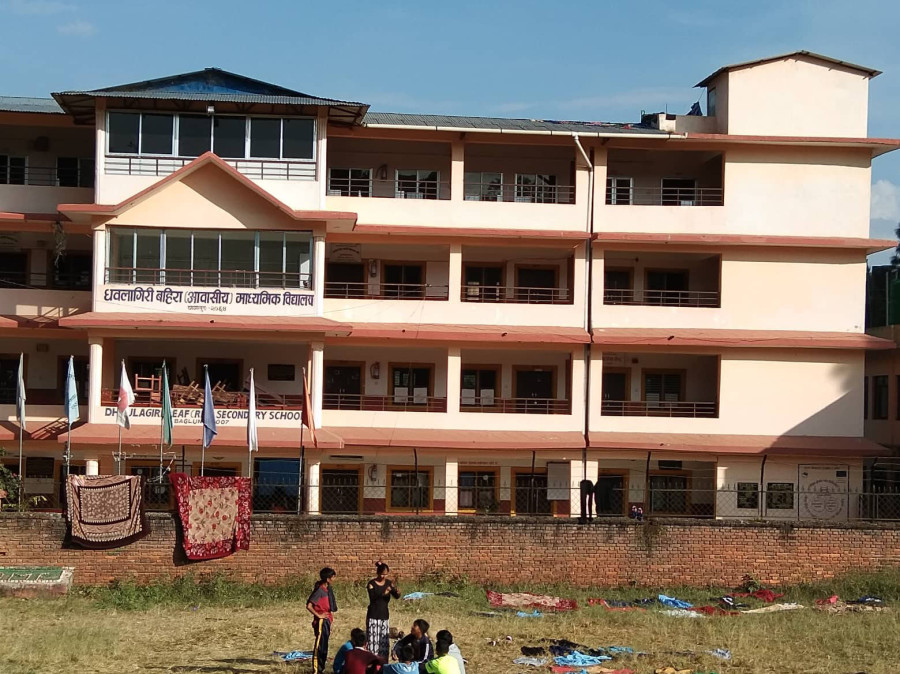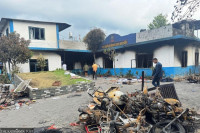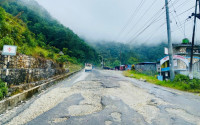Gandaki Province
Communication barrier a major hurdle for the deaf
Unless the Nepali sign language becomes more widely used, deaf people in the country will keep having a difficult time pursuing their ambitions.
Prakash Baral
Santosh Paudel, president of Baglung Deaf Association, teaches sign language at the Dhaulagiri Deaf Residential Secondary School in Baglung district headquarters.
Inside the school’s premises, Paudel, who is deaf, is comfortable with his communication skills. However, every time Paudel steps outside of the school premises, and into the world, he is worried. He becomes especially worried when he has to go to government offices.
“Government officials, like most people, do not understand the Nepali sign language. That is why I always have to take an interpreter with me for communication,” he said.
Sunita Sharma, a high school graduate in computer engineering from the Dhaulagiri Deaf Residential Secondary School, also feels the same anxiousness as Paudel when she’s out of her school premises. “I have to take an interpreter with me everywhere I go, which means I have to manage his/ her expenses, in addition to my own,” said Paudel.
For deaf people like Paudel and Sharma, living a “normal” life is difficult. It becomes more difficult when they have to depend on others for communication. “And as you can imagine, for those like us, jobs don’t come easy. I am a teacher at the deaf school but outside that, it’s difficult for me to get a job,” said Sharma, who is yet to pass a job interview despite being qualified.
“I have passed the written test several times but I always fail in the interview round. The interviewers, whether in a government office or a private one, don’t understand me. And since I can’t communicate any other way, I don’t get selected,” she said.
The National Federation of Deaf Nepal estimates that the country has a deaf population of more than 300,000. Despite the huge number, the Nepali sign language is still in its nascent phase of development, and as it is not widespread yet, deaf people have a tough time pursuing their ambitions—or living a normal life.
Deaf people believe that if the government encourages its staff to learn the sign language, the private sector will follow suit. “Our students, though they possess skillsets as good as or even better than the next person, fail in the real world. The failure to understand them has pushed them in the periphery of the job market in Nepal,” according to Resham Bahadur Shreesh, the headmaster of Dhaulagiri Deaf Residential Secondary School.
And understanding the Nepali sign language is not a tough job, he says. “Anyone can become adept in using the Nepali sign language after a seven to a 10-week training session and can easily communicate with the deaf and dumb,” he adds.
To make the language more widespread, the Baglung Deaf Association and the Dhaulagiri Deaf Residential Secondary School jointly run training sessions on the Nepali sign language every year, inviting government representatives and other officials, but only a small percent of the invitees attend the training, if at all. “We organise the training so that the people sitting in the offices will be able to understand us better, but hardly anybody shows up,” said Shreesh.
Currently, there are around 300 deaf students enrolled in the Dhaulagiri Deaf Residential Secondary School. The school runs a three-year computer engineering course for students who pass the Secondary Education Examination, which is opted by many. There are others who opt for the Council for Technical Education and Vocational Training (CTEVT) courses.
CTEVT is a national autonomous apex body of technical and vocational education and training sector committed for the production of technical and skilful human resources required to the nation. The courses include employment-generating skill training, like beautician, cutting and tailoring, haircutting, plumbing et cetera. But those who take the CTEVT courses too find themselves scraping the bottom of the barrel for job opportunities.
“I have received a six-month training in plumbing from the Council for Technical Education and Vocational Training, but nobody hires me. It’s like they don’t trust us to do a good job,” said Shishir Gurung, another deaf person.
Saraswoti Devi Regmi, chief at women development unit of Baglung Municipality, admits that the hardships deaf people face—whether they be in receiving an education, seeking services, or looking for employment—are more severe: “It’s difficult for them. Since we don’t understand their language, communication is not easy.”
“We once ran a help desk with the help of the representatives of the deaf association to distribute ID cards to the disabled. We haven’t been able to do that again but we plan to coordinate with the association and work together to make the deaf people’s lives a little less difficult,” she said.




 9.12°C Kathmandu
9.12°C Kathmandu.jpg)











